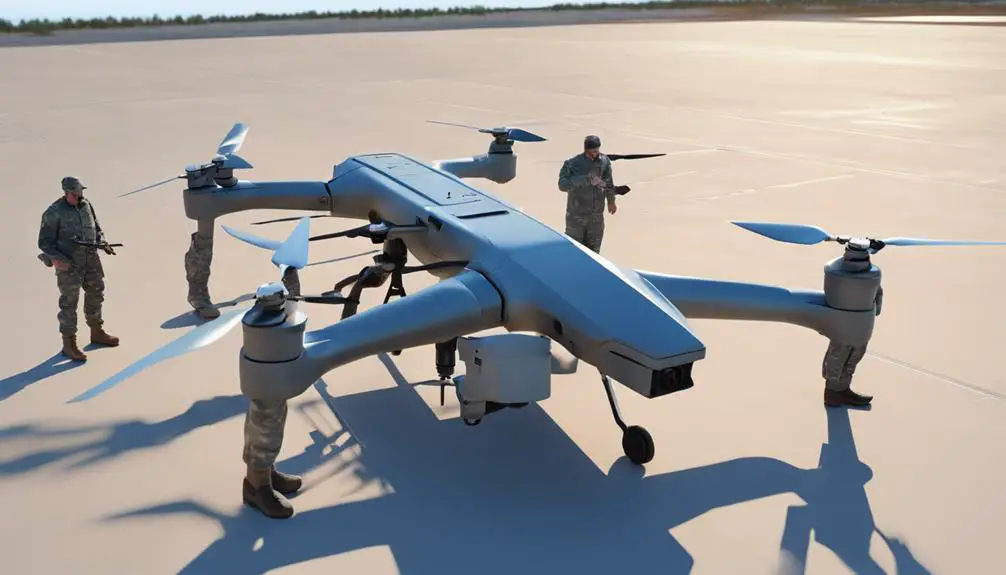Military drones can cost anywhere from $10,000 to over $5 million, depending on their type and capabilities. Basic reconnaissance drones usually fall in the hundreds of thousands, while advanced combat UAVs might exceed several million. Factors like design complexity, technology integration, and payload capacity heavily influence these prices. For instance, medium-sized drones range from $100,000 to $1 million, offering enhanced functionalities. As demand shifts and production scales up, prices may change, making understanding these costs essential for planning. If you're curious about what drives these price variations even further, there's more to explore.
Types of Military Drones
When it comes to military drones, you'll find several types designed for various missions and capabilities. There are reconnaissance drones, built for surveillance and intelligence gathering, allowing you to observe from a distance without putting lives at risk. Then, you've got combat drones, armed with precision weaponry to engage enemy targets while minimizing collateral damage. Some drones are designed for logistical support, delivering supplies to troops in challenging terrains. Additionally, there are swarm drones, which work together to overwhelm defenses, showcasing the power of technology in modern warfare. Each type serves a specific purpose, giving you a glimpse into how they enhance military operations while working to protect freedoms and guarantee safety without direct confrontation.
Factors Influencing Costs
Several factors influence the costs of military drones, including their design complexity, technology integration, and intended mission capabilities. When you look at a drone's design, think about how advanced its features are—more intricate designs often mean higher costs. Technology integration plays a big role too; incorporating cutting-edge sensors, AI, and communication systems can greatly increase expenses. Additionally, the drone's intended mission—whether for surveillance, combat, or logistics—can dictate its cost. A drone built for precision strikes will likely be pricier than one designed solely for reconnaissance. Understanding these factors helps you grasp why military drones can vary so much in price, reflecting the balance between capability and affordability in pursuit of freedom and safety.
Price Range Overview
Military drones can vary considerably in price, typically ranging from hundreds of thousands to several million dollars, depending on their specifications and capabilities. If you're curious about what influences these costs, consider the following factors:
- Size and Payload: Larger drones that can carry heavier payloads usually cost more.
- Technology: Advanced surveillance, targeting systems, and AI capabilities drive the price up.
- Production and Maintenance: Limited production runs and high maintenance needs can affect overall costs.
Ultimately, whether you're looking for a basic reconnaissance drone or a sophisticated combat UAV, understanding the price range can help you make informed decisions aligned with your values of freedom and security.
Cost Comparison by Category
Understanding the price range of military drones sets the stage for a more detailed cost comparison by category, highlighting how different types can fit varying budgets and operational needs. When you look at small tactical drones, you're often seeing price tags between $10,000 and $100,000, perfect for quick surveillance and reconnaissance. Medium-sized drones can range from $100,000 to $1 million, offering more advanced capabilities and endurance. Larger, high-end drones, like armed UAVs, can exceed $5 million, reflecting their complex technology and combat roles. Each category serves distinct purposes, so it's essential to align your choice with your mission objectives and financial resources. Ultimately, evaluating these costs empowers you to make informed decisions that enhance operational freedom.
Future Trends in Drone Pricing
As technology advances, you can expect significant shifts in drone pricing, making them more accessible for a wider range of applications. Here are a few trends to watch:
- Economies of Scale: As manufacturers ramp up production, costs will likely drop, driving prices down for consumers and military buyers alike.
- Modular Designs: Future drones may feature interchangeable parts, allowing you to customize and upgrade without buying a whole new unit, saving you money in the long run.
- Increased Competition: More companies entering the market can lead to better pricing and innovative features, giving you greater choices and enhancing your freedom to select the right drone for your needs.
These trends suggest a bright future for drone enthusiasts and military applications alike.

